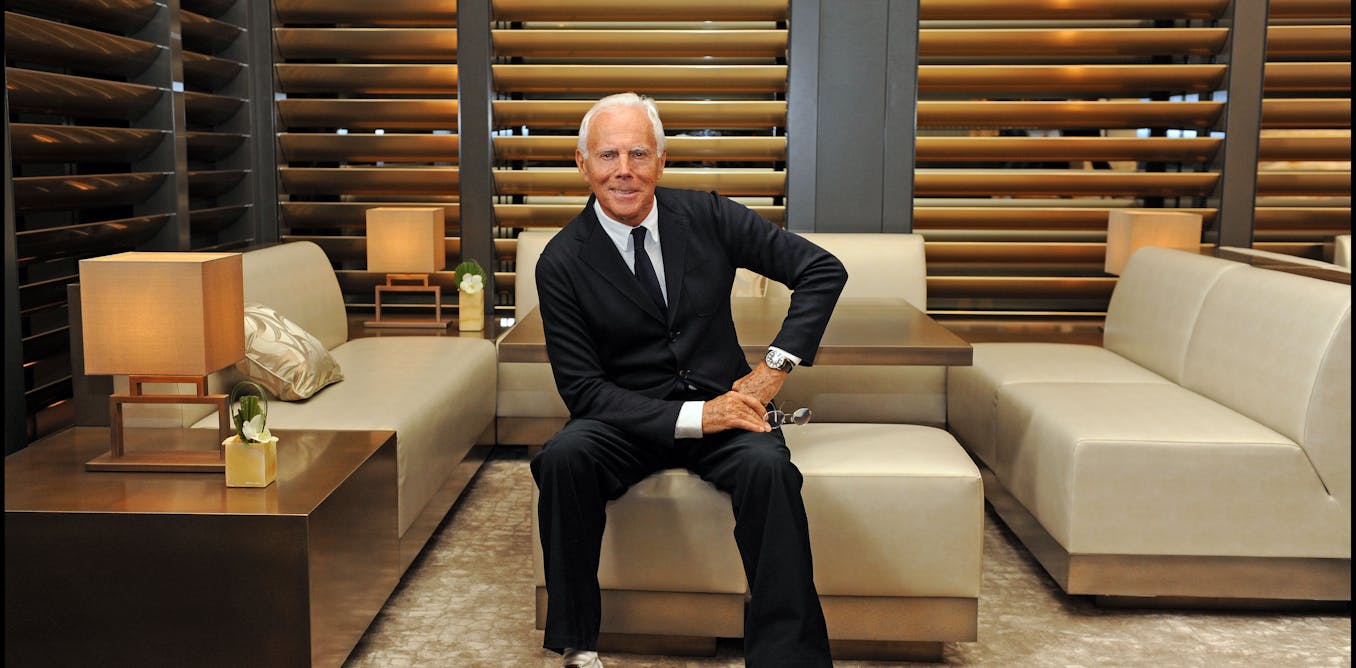Giorgio Armani’s passing at the age of 91 has closed a golden age in high fashion, and consolidated the legacy of a visionary who forever redefined the codes of contemporary style. The designer’s death marks a crucial moment for an empire that generates annual revenues of €2.3 billion euros.
Armani transformed fashion with unstructured silhouettes that challenged decades of sartorial tradition. At a time when shoulder pads dominated the catwalks and men’s suits still followed rigid Victorian codes, the Milanese designer proposed something radically different: sophistication through simplicity.
His genius lay in understanding that true luxury did not shout, but whispered – the relaxed structure and flowing lines of Armani jackets freed both men and women alike from the strictures of extreme formality. Armani’s business success was, in essence, this concept of understated elegance turned into a multi-million-euro empire.
Dressing the dreams of millions
Armani is recognised for having invented red carpet fashion, an achievement that transcends the textile industry and enters the realm of popular culture. From Richard Gere in the 1980 film American Gigolo to today’s stars, the Italian designer understood that dressing Hollywood meant dressing the dreams of millions of people.
His creations did more than just adorn bodies. They constructed characters, defined eras, and set global standards of aspiration. On screen, each Armani suit became a silent expression of what it meant to be elegant, powerful and desirable.
Armani also helped to make the “made in Italy” label synonymous with quality for consumers, elevating Italian manufacturing to the highest levels of prestige. Far more than a fashion designer, he was a cultural ambassador who exported Mediterranean sophistication to global markets, from Tokyo to New York.
The Armani empire is not only a testament to commercial success, but also to the ability to transform a coherent artistic vision into an enduring cultural phenomenon.
A maximalist minimalist
In an industry beholden to ostentation, Armani embraced sober restraint as his creative philosophy. His neutral palettes, exquisite textures and impeccable cuts proved that it was possible to be both revolutionary and subtle. Each garment was an exercise in subtraction, in stripping away the unnecessary to reach the pure essence of the design.
This minimalist approach was not one of coldness, but distilled warmth. His garments enveloped the wearer in a second skin of confidence, transforming clothing from mere attire to psychological armour.
For more than five decades, Armani shaped modern elegance with a clarity of vision that extended far beyond fashion.
Shutterstock
His influence extends from the architecture of his boutiques to the philosophy of life he represented: beauty found in simplicity, power expressed with moderation. Today, as the fashion world mourns this irreparable loss, it is clear that Giorgio Armani did not just dress bodies: he dressed an era.
His legacy will live on in every silhouette that celebrates elegance over ostentation, in every garment that favours subtlety over flashiness, and in every designer who understands that true revolution sometimes talks to us in the quietest of voices.
“Il Signore Armani”, as he was affectionately known, leaves behind not only a commercial empire, but also a masterclass in how authentic artistic vision can transform entire industries. In an increasingly noisy world, his quiet voice now resonates more strongly than ever.
Read more:
When courtroom fashion serves as a calculated legal strategy
An astute entrepreneur
The Armani empire was more than a brand. It was a meticulously structured financial ecosystem, and the business’ design reflects its founder’s strategic vision: Giorgio Armani as the flagship haute couture brand, Emporio Armani as the accessible luxury segment, and Armani Exchange for the youth market. This segmentation allowed the group to reach multiple demographics without undercutting or jeopardising its core business.
In an industry dominated by conglomerates like LVMH and Kering, Armani was the exception: he was both CEO and sole major shareholder of the company, and maintained absolute control over its creative vision and commercial strategy.
This independence was ideological, but also financially astute. Without pressure from external shareholders, the group was able to maintain healthy profit margins and consistently reinvest in its global infrastructure.
The company is estimated to be worth between €6 billion and €7 billion today, but regardless of the exact figure, Armani has established himself as one of the most successful entrepreneurs in the history of fashion.
Beyond clothes
Armani’s financial genius was evident in his ability to diversify. The company operates a line of restaurants and cafés around the world, and is planning, together with UAE-based firm Emaar Properties, to launch a chain of luxury hotels and resorts in major cities including New York and Tokyo. This expansion is the logical extension of a brand that had managed to transcend fashion and become synonymous with an aspirational lifestyle.
The Armani business had also expanded into music, sport and Italian cuisine, creating an ecosystem of mutually reinforcing brands that maximised the value of its intellectual property.
This paid off, as at times when other luxury groups were hit by market fluctuations, Armani showed exceptional resilience – its revenue grew by 16.5% in 2022, despite volatile markets.
The group’s conservative strategy of maintaining a cash reserve of over €1 billion also enabled it to navigate economic crises without relying on external financing or strategic partners. This liquidity provided stability, as well as bargaining power and the ability to make countercyclical investments.
Read more:
Celebrities, blue jeans and couture: how Anna Wintour changed fashion over 37 years at Vogue
A business model to emulate
Armani’s financial success was no fluke. His model combined vertical control of production with strategic geographical expansion, as well as brand management that maximised the price of Armani’s superior quality.
As the fashion world mourns his loss as a designer, financial analysts will be eulogising Armani as a business strategist who built one of the luxury sector’s most profitable and stable companies.
He managed to maintain margins above 20% for decades, expand globally without losing its brand identity, and resist the pull of industry consolidation. All of this makes his legacy required reading for any business school student.
The empire Armani leaves behind is not just a collection of assets. It it is the embodiment of an understanding that true luxury cannot be bought, it must be built. Brand by brand, shop by shop, season after season.



